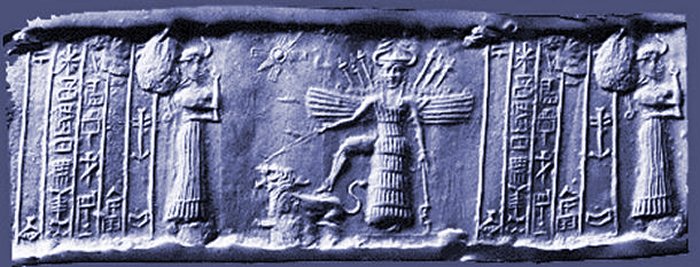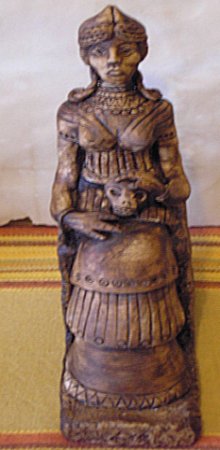Ereshkigal – Ruler Of The Sumerian Underworld And Most Feared Deity In Mesopotamian Pantheon
A. Sutherland - AncientPages.com - Ereshkigal, a granddaughter of Enlil, is the queen of the underworld or Irkalla ( the land of the dead). She is older sister of Inanna (later known as Ishtar) and wife of Nergal, the king of death who brings disease, plague, and all misfortunes caused by heat.
Ereshkigal, whose name means "Queen of the Great Below", is very powerful ruler in her kingdom of the dead and her judgment and laws are always indisputable.
Ereshkigal Was Given The Underworld For Her Domain
In Sumerian religion, in the very beginning, the universe was divided into three regions each of which became the domain of a god. Anu, Sky Father, was also "King of the Gods", "Lord of the Constellations, Spirits and Demons", and "Supreme Ruler of the Kingdom of Heaven", which was his domain. The earth was given to Enlil. Ea became the ruler of the waters.
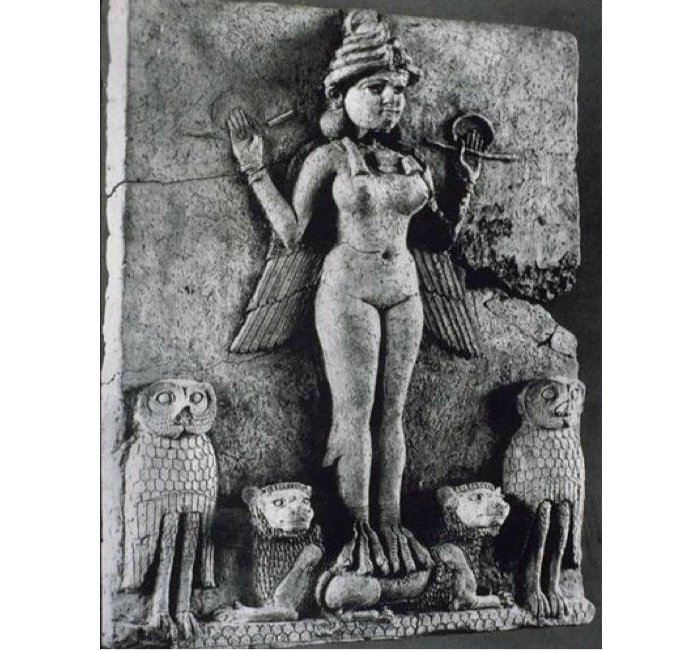
Ishtar/Inanna) or possibly female demon Lilith, attended by owls and lions. 2025-1763 BC, terracotta relief panel, Credits: ARTstor, http://library.artstor.org
Together they constituted the triad of the Great Gods.
According to the Epic of Gilgamesh (c.1850 BC), Ereshkigal was “given the underworld for her domain” and she became the ruler of the Underworld.
However, in another story (similar to that of Ovid’s tale of Hades’ and abduction of the goddess Persephone), Ereshkigal is kidnapped by her half-brother, the dragon Kur, and taken to the underworld where she is made queen.
Inanna Descends To Gloomy Kingdom Of The Dead
No one could ever question her decisions and those who enter her world can no longer return to the world of the living.
The Kingdom of Ereshkigal is a gloomy land of shadows, with no future and no hope. To this abyss of hopelessness are thrown not only sinners but also good and bad, great and small, God-fearing people and blasphemers. All of them become powerless and pale forever.
See also:
Mighty Enlil Of The Sumerian Pantheon Of Gods
Ur-Nammu – Popular And Accomplished Ruler Of Sumer
Sumerian 'Mask Of Warka' From Uruk: Sculptured Face May Depict Goddess Inanna
Uruk: The First City Built By King Gilgamesh 4,500 Years Ago
The exception is Inanna, the goddess of life and fertility, whose descent to Ereshkigal’s underworld is believed to be one of the most known Sumerian myths. Inanna and Ereshkigal have never been good friends. Moreover, Inanna enters the underworld in an unsuccessful attempt to deceitfully take power over the abyss of Ereshkigal.
She is punished by her and killed and her corpse hangs on a hook. It seems that even gods who try to convince Ereshkigal to release Inanna, are powerless to help, because in the underworld, there are rules and principles, which have to be followed.
Finally Ereshkigal gives Inanna’s corpse to the gods, and they revive the goddess with water of life and food. Inanna ascends to the upper world, but must send someone down to take her place in the land of the dead.
She decides to send her husband, Dumuzi as the substitution because Dumuzi is the one who has not mourned her death.
Appearance of Ereshkigal is not exactly known.
The Akkadians associated her with their own Semitic underworld goddess, Allatum. There is, however, a rectangular, fired clay relief panel depicting a naked woman standing on two lions and flanked by owls, holding a rod and ring in her hands.
These two symbols are often depicted on Mesopotamian stelas, cylinder seals and reliefs.
Whether this panel depicts Inanna or Ereshkigal is still under debate. It has even been proposed that it may represent female demon Lilith.
With few exceptions, Ereshkigal had no cult center in Mesopotamia and as a result, she is only occasionally encountered outside the literature. Inscriptions confirm that temples dedicated to her existed in Kutha, Assur and Umma.
Her coalition government with Nergal begins in the old-Babylonian period (1830 - 1531 BC). During the first millennium BC, Nebuchadnezzar II - a Chaldean king of the Neo-Babylonian Empire, who reigned c. 605 BCE – c. 562 BC - rebuilt her temple in Kutha (Cuthah).
Written by – A. Sutherland AncientPages.com Staff Writer
Copyright © AncientPages.com All rights reserved. This material may not be published, broadcast, rewritten or redistributed in whole or part without the express written permission of AncientPages.com
Expand for referencesReferences:
Cotterell & R. Storm, The Ultimate Encyclopedia of Mythology
McIntosh, Ancient Mesopotamia: New Perspectives
More From Ancient Pages
-
 Sole Survivor Recalls An Incredible Unexplained Mountain Mystery
Featured Stories | Aug 7, 2023
Sole Survivor Recalls An Incredible Unexplained Mountain Mystery
Featured Stories | Aug 7, 2023 -
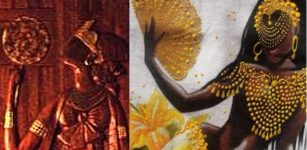 Oshun Goddess Of Yoruba People Who Brings All Things That Make Life Worth Living
African Mythology | Mar 29, 2019
Oshun Goddess Of Yoruba People Who Brings All Things That Make Life Worth Living
African Mythology | Mar 29, 2019 -
 Mysterious Biblical Celestial City And Its Connection To The North Star – Nonhuman Hands – Part 1
Ancient Mysteries | Feb 22, 2021
Mysterious Biblical Celestial City And Its Connection To The North Star – Nonhuman Hands – Part 1
Ancient Mysteries | Feb 22, 2021 -
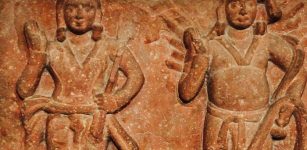 Agni: Hindu God Of Divine Illumination And One Of The Three Supreme Deities Of Vedic Lore
Featured Stories | May 3, 2018
Agni: Hindu God Of Divine Illumination And One Of The Three Supreme Deities Of Vedic Lore
Featured Stories | May 3, 2018 -
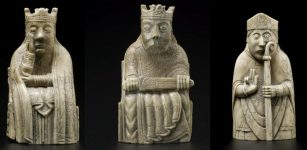 Beautiful Viking Uig Chessmen Recreated In 3D Images
Archaeology | Sep 17, 2019
Beautiful Viking Uig Chessmen Recreated In 3D Images
Archaeology | Sep 17, 2019 -
 Illuminated Ancient Manuscripts Reflect 1,000 Years Of Human History
Artifacts | Sep 12, 2015
Illuminated Ancient Manuscripts Reflect 1,000 Years Of Human History
Artifacts | Sep 12, 2015 -
 Ancient DNA From The Green Sahara Reveals North African Lineage – Study
DNA | Apr 3, 2025
Ancient DNA From The Green Sahara Reveals North African Lineage – Study
DNA | Apr 3, 2025 -
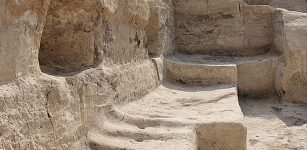 Ancient Adobe Throne Found At Aslantepe, An Acient Hittite Site, Turkey
Civilizations | Aug 29, 2015
Ancient Adobe Throne Found At Aslantepe, An Acient Hittite Site, Turkey
Civilizations | Aug 29, 2015 -
 Did The Plague Of Athens Come From Egypt Or Is It A Myth?
Archaeology | Dec 13, 2023
Did The Plague Of Athens Come From Egypt Or Is It A Myth?
Archaeology | Dec 13, 2023 -
 Ancient Jaintia Kingdom And The Garden Of Monoliths And Dolmens
Featured Stories | Nov 8, 2016
Ancient Jaintia Kingdom And The Garden Of Monoliths And Dolmens
Featured Stories | Nov 8, 2016 -
 Tomb Of God Thoth’s High Priest Discovered In Ancient Egyptian Necropolis
Archaeology | Feb 27, 2018
Tomb Of God Thoth’s High Priest Discovered In Ancient Egyptian Necropolis
Archaeology | Feb 27, 2018 -
 Huge Ancient Roman Kovachevsko Kale Fortress And Discovery Of A Horreum In Bulgaria
Civilizations | Dec 15, 2015
Huge Ancient Roman Kovachevsko Kale Fortress And Discovery Of A Horreum In Bulgaria
Civilizations | Dec 15, 2015 -
 Toruń Massive ‘Roundels’ Date Back 7,000 Years – Archaeologists Say
Archaeology | Jul 6, 2020
Toruń Massive ‘Roundels’ Date Back 7,000 Years – Archaeologists Say
Archaeology | Jul 6, 2020 -
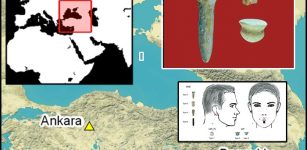 Evidence Of Stone Age Ear and Lip Piercing Found At Boncuklu Tarla Neolithic Site In Türkiye
Archaeology | Mar 14, 2024
Evidence Of Stone Age Ear and Lip Piercing Found At Boncuklu Tarla Neolithic Site In Türkiye
Archaeology | Mar 14, 2024 -
 Map May Confirm The Legend Of The Mysterious Lost Sunken Welsh Kingdom Of Cantre’r Gwaelod In The Black Book Of Carmarthen
Archaeology | Aug 21, 2022
Map May Confirm The Legend Of The Mysterious Lost Sunken Welsh Kingdom Of Cantre’r Gwaelod In The Black Book Of Carmarthen
Archaeology | Aug 21, 2022 -
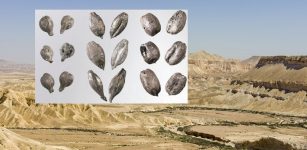 When And Why Negev Highlands’ Agricultural Settlement Was Abandoned? – Researchers Have Answers
Archaeology | Jul 28, 2020
When And Why Negev Highlands’ Agricultural Settlement Was Abandoned? – Researchers Have Answers
Archaeology | Jul 28, 2020 -
 Bees Originated From An Ancient Supercontinent Millions Of Years Earlier Than Previously Thought
Evolution | Jul 31, 2023
Bees Originated From An Ancient Supercontinent Millions Of Years Earlier Than Previously Thought
Evolution | Jul 31, 2023 -
 Underwater Rock Carvings Of Ancient Egyptian Pharaohs Discovered Near Aswan
Archaeology | Jul 20, 2024
Underwater Rock Carvings Of Ancient Egyptian Pharaohs Discovered Near Aswan
Archaeology | Jul 20, 2024 -
 The ‘Chinese Pyramids’ And The Pole Star
Archaeology | Nov 30, 2018
The ‘Chinese Pyramids’ And The Pole Star
Archaeology | Nov 30, 2018 -
 Ancient Secrets Of Mistletoe – Sacred Celtic Plant With Magical Powers
Ancient Traditions And Customs | Dec 17, 2024
Ancient Secrets Of Mistletoe – Sacred Celtic Plant With Magical Powers
Ancient Traditions And Customs | Dec 17, 2024

